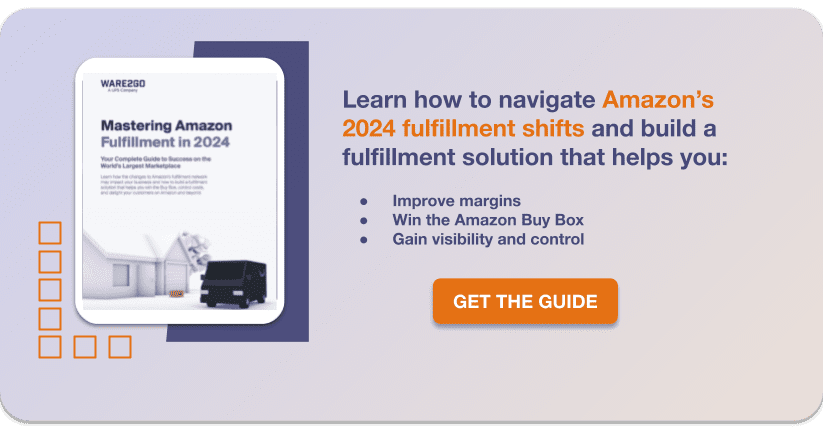Fifty percent of customers begin online shopping with Amazon, making it essential to optimize your listings to reach a broad audience. Amazon’s global reach means you can access a huge customer base without needing a physical storefront.
Amazon fulfillment is the most straightforward option for sellers with standard-size items. Amazon handles all aspects of fulfillment and customer service, and it enables Amazon Prime status through its internal fulfillment and delivery network.
Download Ware2Go’s Amazon fulfillment downloadable to learn how to grow your Amazon business.
Selling on Amazon comes with its complexities, especially when considering factors like oversized item fees under FBA. Is the convenience of FBA worth the expense and lack of control, or could FBM or SFP be a more cost-effective alternative? These are critical questions for sellers aiming to optimize their Amazon strategy. As logistics experts, we specialize in understanding the nuances of fulfillment. Keep reading to gain insights, and take our quiz to discover the best fit for your eCommerce business:
Schedule a Free Consultation with an Amazon Fulfillment Expert
What Is Amazon Fulfillment?
Amazon fulfillment is a service provided by Amazon’s in-house fulfillment and logistics network that handles inventory storage, management, packing, and picking and shipping orders.
Amazon handles all fulfillment logistics, shipping, and customer inquiries on the seller’s behalf, takes a percentage of the sale according to their fee schedule, and disburses payment to the seller every 1–2 weeks.
Sellers are responsible for prepping and shipping their inventory to Amazon’s warehouses according to FBA standards. This is a detailed process that includes packaging, adding scannable labels according to product type, uploading, and monitoring reporting. Failure to follow these protocols exactly will result in additional fees and often a rejection of the inbound shipment.
Navigating Amazon’s fulfillment system can be tricky for third-party sellers. To make the best decision for your business, it’s crucial to understand both the benefits and drawbacks of using Amazon fulfillment. Let’s explore the pros and cons of this fulfillment option.
Pros of FBA
- Prime status: Your products gain Prime status by enrolling in the Amazon FBA program. They appear at the top of search results and attract loyal Prime shoppers who spend twice as much as average Amazon shoppers.
- Convenience: Amazon manages the e2e fulfillment process and has a proven track record of high service levels.
- Customer service: Amazon manages customer interactions after the purchase, from delivery tracking to returns.
- Easy returns: Amazon handles the logistics of product returns, inspecting items, and restocking inventory, making it easy for sellers to accept customer returns.
Cons of FBA
- Brand association with Amazon: When your products arrive in Amazon-branded packaging, customers associate them more with Amazon than your brand, impacting brand recognition and loyalty.
- Comingling of products leading to issues with quality: FBA uses a practice known as product comingling, where identical products from different sellers are stored together in the fulfillment centers. This streamlines the process; however, if a customer receives a damaged or counterfeit product from another seller, this can damage your reputation and lead to a loss of future sales.
- Long-term storage fees: If you store your products in Amazon’s fulfillment centers for an extended period, they’ll charge you for this, which can eat into your profits, especially for seasonal or slow-moving issues.
- Inventory restrictions: Amazon imposes restrictions on certain products, including hazardous, counterfeit, and offensive materials.
- FBA prep standards: Amazon has strict prep standards, such as specific packaging and labeling that may not align with your current order fulfillment processes. Not complying with these standards can incur further fees or even lose selling privileges.
- Slow dock-to-stock times: There may be delays in processing inventory when it arrives at fulfillment centers, which means longer wait times before the item is made available for sale. This can affect the seller’s ability to meet customer demands.
- Poor customer service for third-party party sellers: Some FBA sellers have found that their customers can face delays when resolving issues via FBA’s customer service team.
- Constantly changing fees: Amazon often changes its fee structure, making it difficult for sellers to budget accurately.
- Peak season surcharges: Amazon can apply extra fees on sellers during peak season, increasing expenses and reducing profitability.
- Lack of inventory flexibility: As an FBA seller, once you’ve committed inventory to Amazon, you won’t get it back. You won’t have the option of selling it elsewhere or bundling it with another product for a special promotion. You’ll have to sell it as it is or have it destroyed by Amazon if it doesn’t sell.
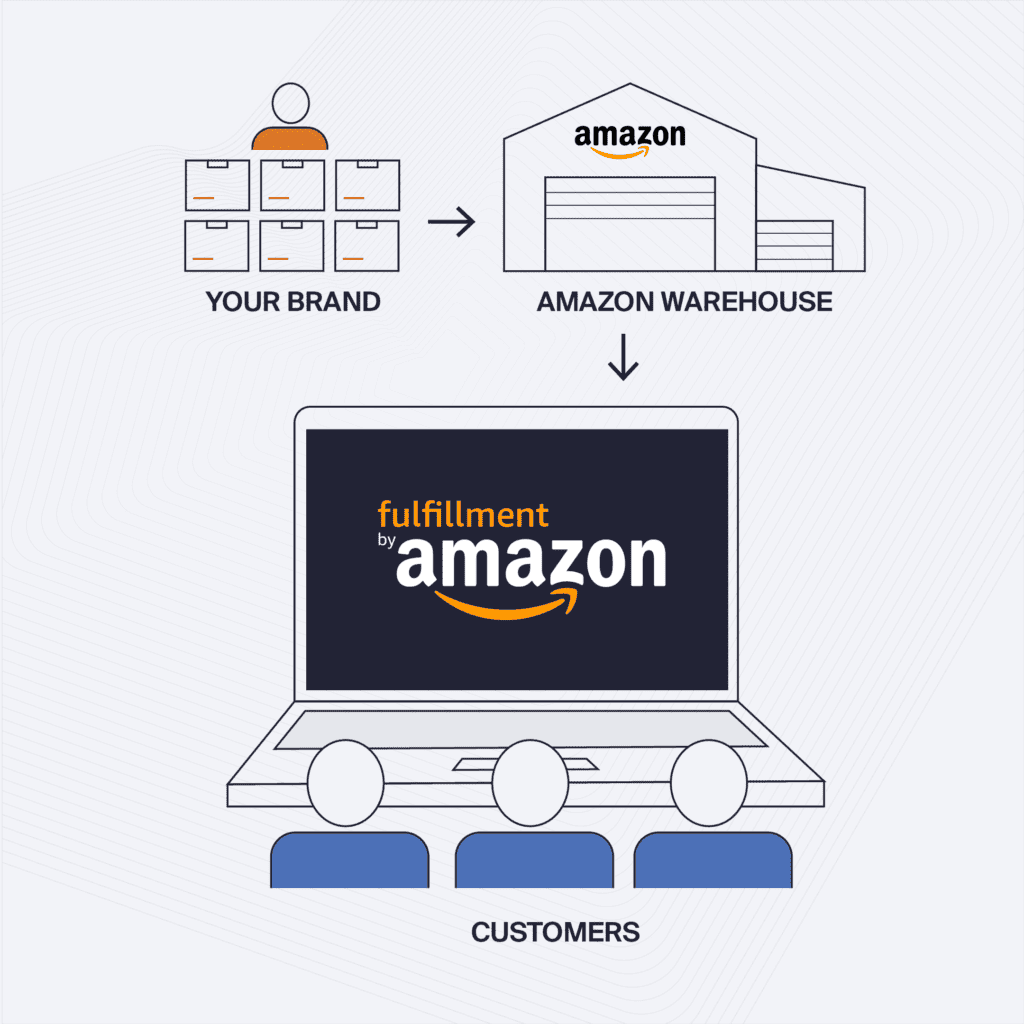
Amazon FBA Storage Limits
At first, FBA storage limits allowed sellers to store products at FBA warehouses for up to 12 months at reasonable storage rates. However, as the program became more popular with sellers and FBA warehouses started filling up, Amazon began to prioritize fast-turning inventory and incentivize FBA sellers to store only a few week’s supply at a time.
In 2020, Amazon announced limits on the storage of new products and began using sales history (what Amazon calls an Inventory Performance Index, or IPI) to impose new limits on existing items. Amazon seemed to be sending a message that it was moving from an inventory storage solution to a fulfillment-only solution.
The Amazon Standard Identification Number level restrictions caused many sellers to experience stockouts on their most popular items, limiting their growth and negatively affecting their advertising and search results due to the Amazon algorithm’s preference for items less likely to go out of stock.
In April 2021, Amazon announced yet another change to inventory limits. Limits would no longer be at the ASIN level but at the account level, dropping some sellers’ storage capacity by 20–50%. This announcement came just before sellers started to stock up for Amazon Prime Day and persisted into peak holiday preparations, leaving many third-party sellers concerned that they couldn’t keep their high-velocity SKUs in stock to keep up with seasonal demand.
In 2023, Amazon revamped its FBA storage limits system, replacing weekly restick and quarterly storage volume limits with monthly FBA capacity limits. Higher capacity limits are granted to sellers with higher Inventory Performance Index (IPI) scores, demonstrating the importance of sell-through rates. New professional sellers aren’t subject to these limits initially, but seasoned sellers face them after 39 weeks.
What is FBM?
Fulfillment by Merchant (FBM) is a method in which sellers are responsible for storing, packing, and shipping orders directly to customers from their own or third-party warehouses. This method gives sellers greater control over their inventory. Still, in contrast to FBA, where Amazon is responsible for storing, packing, and shipping, FBM allows sellers to oversee the entire fulfillment process.
This provides sellers with flexibility and scalability and makes it easy to adjust inventory levels, update product listings, and implement pricing strategies without being constrained by Amazon. For sellers operating in a niche or dynamic market, this allows them to meet fluctuating demands.
FBM allows sellers to provide customized packaging to strengthen their brand identity with customers.
Another advantage of sellers opting for FBM is that it can save on costs. As sellers manage their inventory and fulfillment, they aren’t subjected to monthly storage fees, fulfillment fees, and other costs associated with FBA. This is a great perk for sellers with slow-moving items, as it means you won’t encounter long-term storage fees.
Despite the greater control FBM provides FBA, it does come with challenges. Namely, it requires a larger upfront investment so sellers can find a warehouse space and packaging materials and organize shipping plans. Sellers also manage customer service inquiries, returns, and refunds.
Overall, FBM involves lower fulfillment costs than FBA. Still, sellers must consider whether they have the operational efficiency and resources to manage customer inquiries and fulfill orders promptly.
Competitive Advantage for FBM Sellers
Amazon FBM sellers can manually change their default handling time from 2 days to 1 day. The default handling time is the amount of time merchants need to pick, pack, and ship their orders, and it’s used to calculate a product’s estimated delivery time.
Amazon stated that products with a shorter default handling time would have a faster delivery promise and would be more likely to win the ‘featured offer’ spot. We also know that Amazon’s algorithm has always favored products with faster delivery times, so switching to a 1-day default handling time will improve search rankings and ad performance. This gives FBM sellers a competitive edge over their competitors who only have the operations to support 2-day handling times.
FBM Fulfillment Costs
Amazon charges a referral fee, depending on the product type sold. This typically ranges from 6% to 45%. In the table below, we’ve listed some examples of the referral fees you may be charged depending on the product category:
| Fee Type | Fee Amount |
| Monthly Subscription Fee | $49.99 per month |
| Per-Item Selling Fee | $0.99 per item sold (waived with subscription) |
| Referral Fee | Depends on the product category: |
| • Clothing and Accessories: 17% | |
| • Computers: 8% | |
| • Home and Kitchen: 15% | |
| • Lawn and Garden: 15% |
What Is Amazon Seller Fulfilled Prime (SFP)?
The third fulfillment option for Amazon sellers is Amazon SFP (Seller Fulfilled Prime). The Seller Fulfilled Prime program gives sellers the best of both worlds. The seller handles all fulfillment and shipping processes and customer interactions either through an in-house solution or an outsourced fulfillment partner. The key difference between SFP and FBM is that SFP listings carry the Prime badge.
The Amazon SFP program was created to free up valuable warehouse space in Amazon’s warehouses and to add more sellers and options to the Amazon Prime program. Amazon’s priority for its storage space and warehouse labor is Amazon private label brands, so the growing scarcity of warehouse space could ultimately benefit sellers who want to fulfill their products without giving up their Prime status.
For several years, the SFP program was closed to new applicants, but Amazon reopened SFP enrollment on October 1, 2023.
Amazon screens all applicants to the program by enrolling them in a trial period where their listings do not have the Prime badge. All sellers must meet Prime’s same-day fulfillment and 2-day delivery requirements before being officially accepted.
SFP Requirements
SFP requirements are often difficult to maintain: same-day fulfillment, Saturday fulfillment, and 1- to 2-day page view metrics require integrated technology, a targeted marketing strategy, and a strategic approach to building your shipping region automation template.
Standard Size vs Oversized and Regional Shipping Requirements
Amazon’s fulfillment network is optimized for small, lightweight products, so the FBA pricing structure incentivizes sellers to fulfill those products through FBA and larger products through SFP. There are 3 size categories with different program requirements: standard, oversized, and extra large.
Anything over 20 pounds and under 50 pounds falls into the oversized category. Items (regardless of weight) exceeding dimensions of 18” (longest side), 14” (median side), and 8” (shortest side) are classified as oversized.
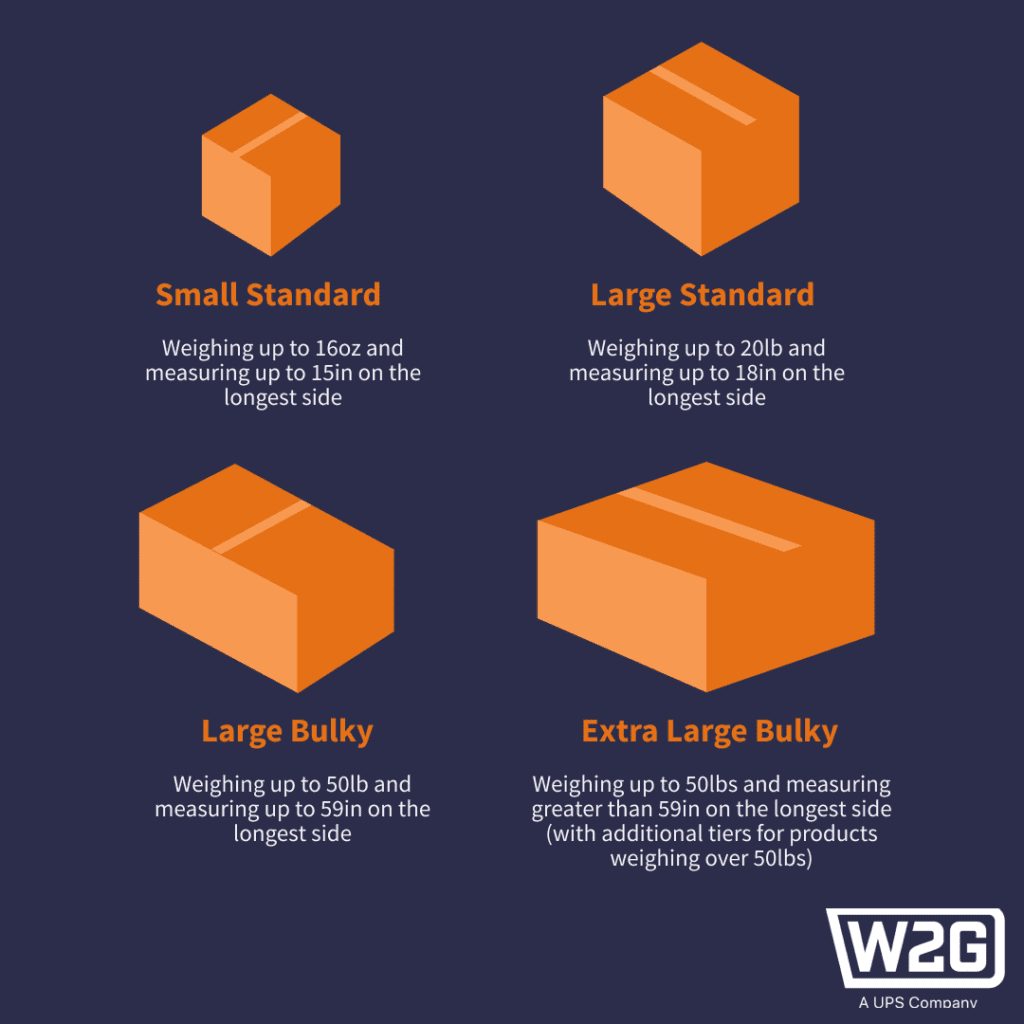
Anything weighing more than 50 pounds or measuring longer than 96 inches is classified as Extra Large.
1- and 2-Day Delivery Coverage
SFP requires that a certain percentage of shoppers see a 1- to 2-day delivery guarantee when they view your listing — regardless of whether they purchase. Page view requirements for standard and oversized products are different:
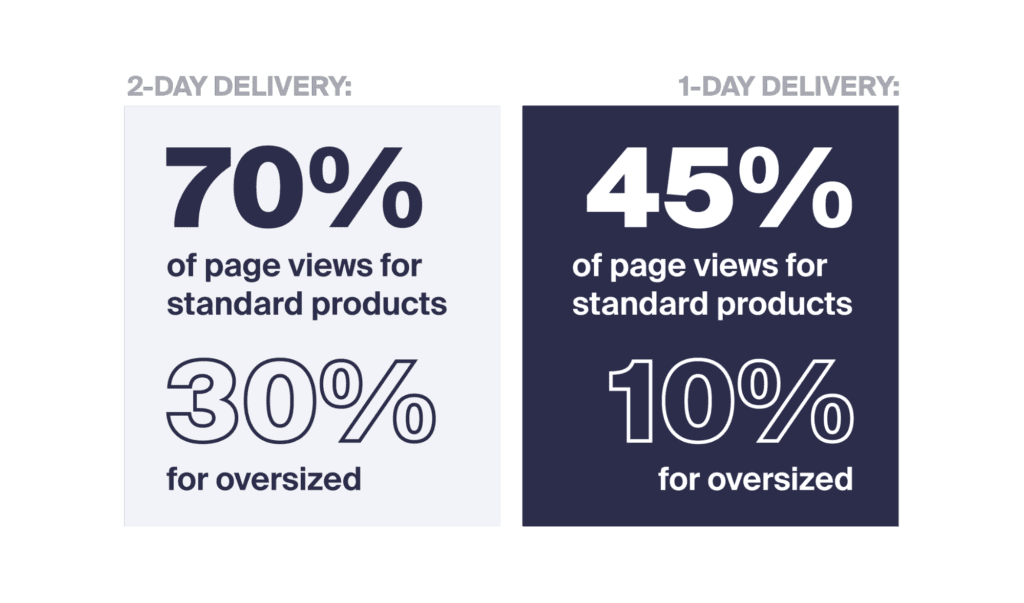
As Amazon continues to invest significantly in a fulfillment infrastructure to support even faster delivery for Prime members, they hope to create a streamlined and consistent delivery experience for all Prime purchases, regardless of the listing seller or fulfillment service.
Amazon has stated that they will revisit SFP requirements quarterly, and SFP sellers should expect requirements to evolve.
SFP Fulfillment Costs
As an SFP seller, you need to offer free standard shipping on Prime orders and are required to ensure it reaches the customer in the Prime period. SFP costs are mostly based on product size, shipping carrier, and order volume.
You’ll also need to pay a referral fee for each item sold, typically around 15%.
It’s difficult to precisely estimate the cost of SFP shipping because costs are variable based on the number of warehouses you need to stock in order to meet Prime delivery requirements. It also depends on how optimized your network is to enable ground shipping rather than air.
Choosing the Right Amazon Fulfillment Solution(s)
Many FBA sellers are rethinking their approach to Amazon fulfillment. Relying on FBA alone is proving to be a single point of failure. Amazon’s inventory limits and extended dock-to-stock times simply can’t support high-velocity sales volumes. Sellers are likely to sell out of products before getting another shipment inbounded, resulting in lost sales and lower search rankings on Amazon.
The solution for many sellers may be to take a multi-threaded approach to fulfillment. Rather than relying solely on FBA, sellers can create 2 SKUs under a single ASIN: One SKU is fulfilled by Amazon and the other is fulfilled by the merchant. Once the FBA SKU sells out, the seller can switch to their fulfilled-by-merchant SKU until FBA is re-stocked.
By having a backup fulfillment method in place, merchants lower their risk of stockouts. If they outsource FMB fulfillment to a reliable 4PL or 3PL network, they can provide the same 1- to 2-day delivery experience their customers have come to expect from Prime orders. FBM can be considered a backup plan for FBA when inventory limits hinder growth.
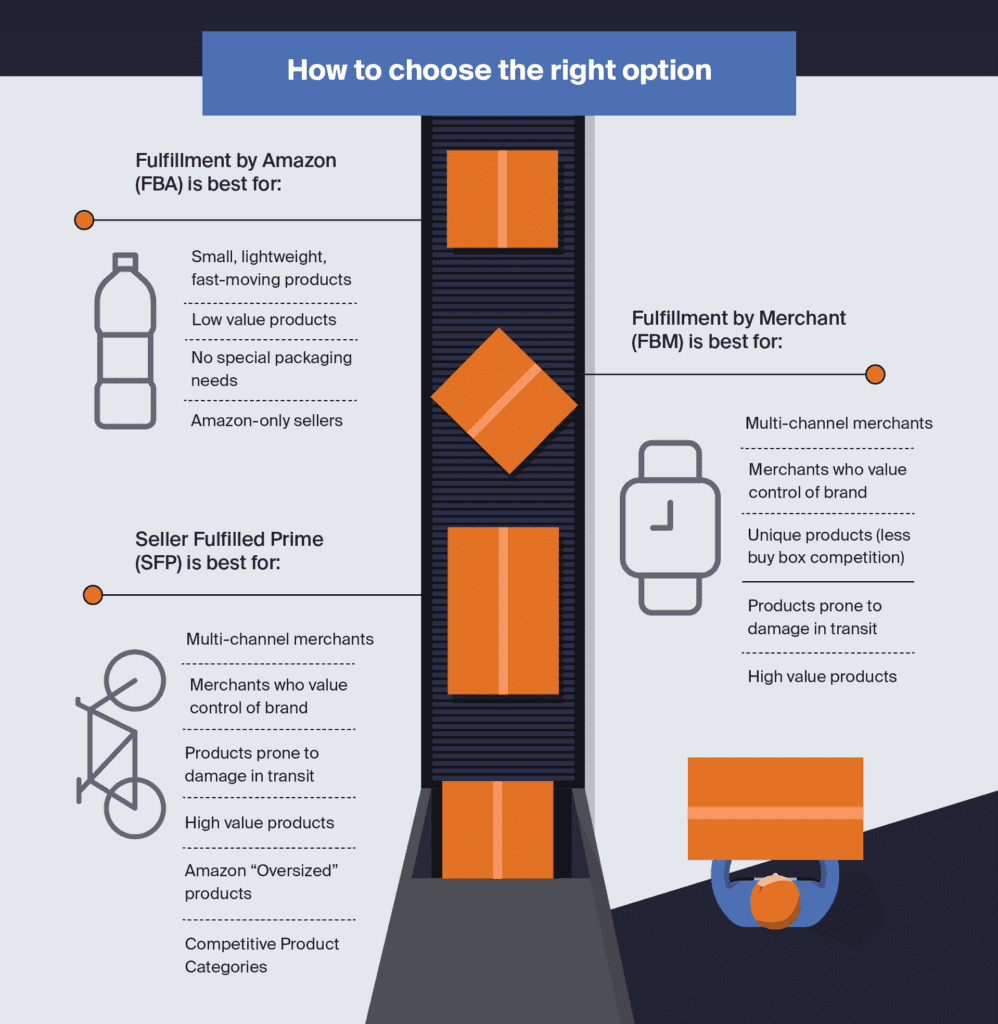
FBA vs SFP
If you’re wondering whether Amazon FBA or SFP is the best option for your Amazon fulfillment, the answer is in your product profile.
Products Best-Suited for FBA:
- Standard-sized items: Amazon’s requirements for standard size are 2-fold: Items must weigh less than 20 pounds and ship in a box smaller than a shoebox. Regarding fulfilling and shipping smaller inventory, Amazon’s network is best suited for nationwide coverage and new weekend requirements.
- Fast-moving items: Amazon’s storage rates are more competitive for fast-moving SKUs. This enables you to store more inventory in Amazon’s warehouse and inbound less often.
Amazon FBA may be convenient for some sellers. Still, due to the loss of visibility and strict size requirements of the program, sellers should consider opting instead for SFP if their products fall under any of the following categories:
- Heavy or bulky: FBA’s definition of oversized may surprise you. Remember that the additional fees associated with products over 20 pounds or larger than a shoebox may outweigh increased sales with Prime status.
- High value: The more touchpoints in your supply chain, the more likely items are to be damaged. Protect your high-value inventory by shipping directly to your fulfillment partner rather than adding the extra step of prepping and labeling it according to FBA’s standards. Additionally, the risk of blending your genuine product with a possible counterfeit may be too great.
- Seasonal: If most of your sales come in the fourth quarter, Amazon’s peak season surcharges will eat into your profits. Additionally, many sellers complain that storage and ADV minimums are set according to peak season sales, meaning sellers with highly seasonal products will be stuck paying for unused space in the off-season.
How to Meet SFP Requirements
While the SFP standards may feel too stringent for many sellers, it’s possible to stay compliant with a qualified 4PL like Ware2Go. In the video below, Ware2Go’s Head of Supply Chain explains how Ware2Go’s insights into geographic patterns of demand and flexible warehouse network enable SFP compliance for third-party Amazon sellers.
How to build a successful SFP network:
- Carry inventory closest to demand: Using machine learning and historical sales data to determine your highest-concentrated pockets of demand, you can prioritize 1- to 2-day delivery to those markets and easily meet Amazon’s fast shipping service requirements for oversized items. Stocking a distributed warehouse network requires a greater capital investment in inventory. But research shows that 2-day delivery guarantees increased top-line revenue by up to 20% and lowers your overall cost-to-serve.
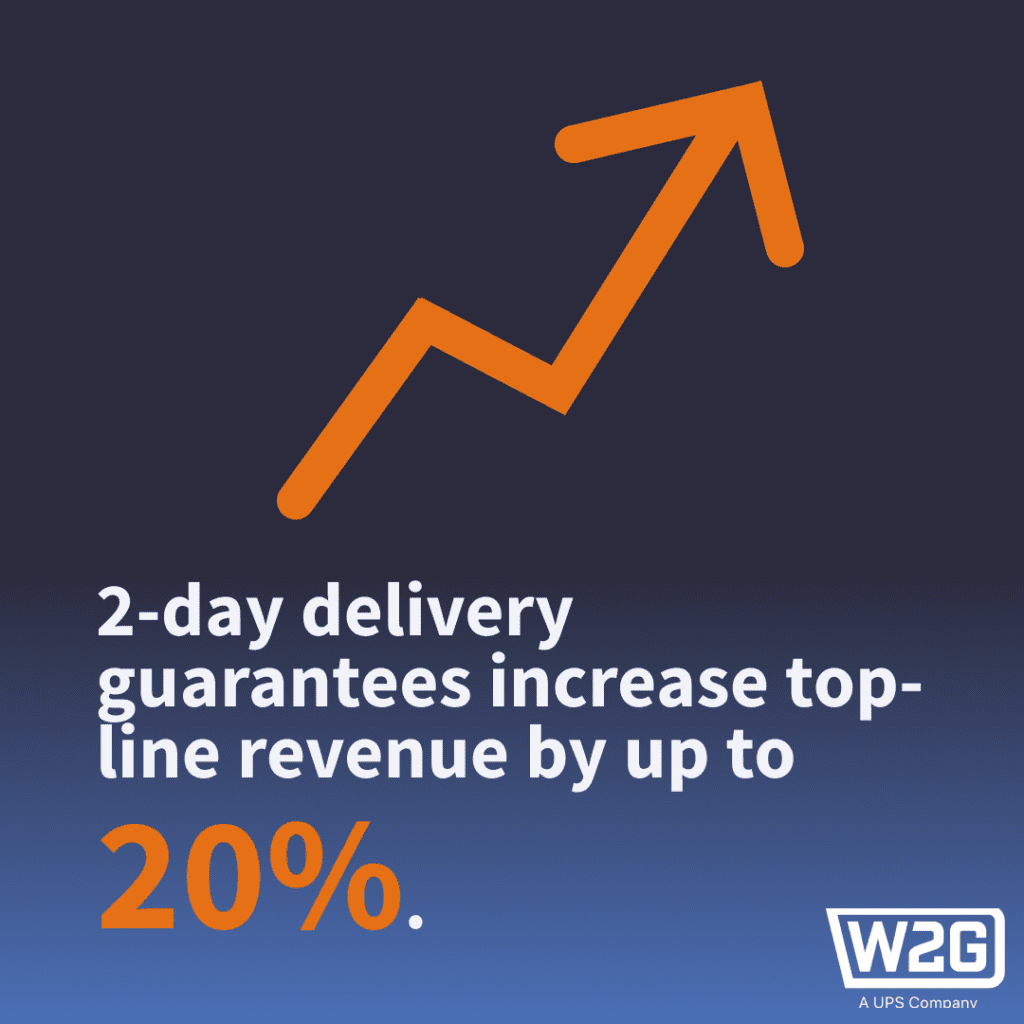
- Prioritize ground shipments. Many sellers may be tempted to rack up next-day air charges to maintain Prime status, but, especially for oversized items, next-day air prices will eat up your margins. Distributing inventory across a 3PL network is the only way to meet SFP standards without eroding profitability.
- Optimize demand forecasting: Saturday fulfillment is a new ask for many warehouses, and understanding how to staff appropriately for demand will be the key to their success. Choose a fulfillment specialist partner with the technology to predict weekend order volume to help warehouse partners ensure they’re sufficiently staffed to fulfill orders on time.
- Update all product packaged weight and size dimensions. SFP delivery standards for oversized items are much more lenient, but you must update your account settings. If your product dimensions aren’t saved in your account settings, the default classification will be standard size, and you’ll be held to those rigorous standards.
End-to-End Amazon Fulfillment Support
When deciding between FBA and alternative options such as SFP or FBM, several factors come into play. FBA offers advantages like Prime status for better visibility, global reach through Amazon’s network, shipping discounts, and streamlined returns.
However, disadvantages include brand association with Amazon, product commingling, long-term storage fees, inventory restrictions, strict prep standards, customer service challenges, and limited inventory flexibility. Many see SFP as the best of both worlds, offering both Prime status and control over fulfillment costs, inventory management, and access to customer data.
Ultimately, selling on Amazon is complicated. There’s no one-size-fits-all fulfillment solution. Third-party sellers must create a multi-threaded solution on Amazon to increase margin and decrease risk.
Ware2Go, a UPS Company, offers the industry-leading Amazon fulfillment solution — with FBA prep, FBM, and SFP services under one roof.
Schedule a call with Ware2Go to learn how you can scale your business with on-demand fulfillment.



